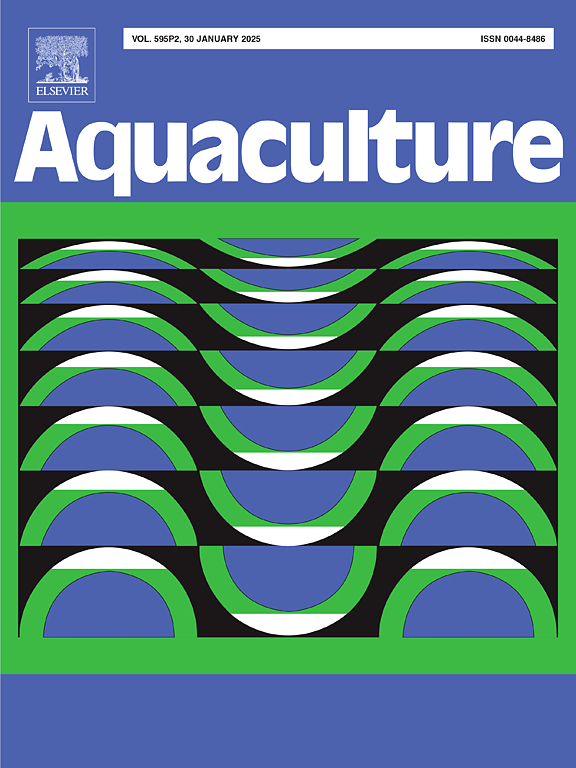Removal of residual antibiotics from aquaculture effluents by denitrifying woodchip bioreactors
IF 3.9
1区 农林科学
Q1 FISHERIES
引用次数: 0
Abstract
The aquaculture industry lacks effective and economical treatment processes to reduce the risk of antibiotic residues in its effluents. In this study, the removal performance of end-of-pipe denitrifying woodchip bioreactors on four commonly used antibiotics was determined. Laboratory batch experiments were performed to investigate the abiotic adsorption capacity of woodchips, while laboratory continuous-flow tests and monitoring of full-scale woodchip bioreactors in the field were performed to investigate antibiotic removal by woodchips during treatment of aquaculture effluents. Adsorption of oxolinic acid was most effective, with the highest measured adsorption capacity of 21 μg g−1 achieved at an equilibrium concentration of 15 μg L−1 in the water. Binding of trimethoprim and sulfadiazine was well described by Langmuir isotherms with maximum adsorption capacities of 106 μg g−1 and 27 μg g−1 respectively. In contrast, florfenicol was poorly adsorbed by woodchips. The results from continuous-flow experiments demonstrated the removal efficiencies for trimethoprim, sulfadiazine, and oxolinic acid to be 89 %, 64 %, and 63 %, respectively, while florfenicol was not effectively removed.
During the monitoring of a full-scale bioreactor, removals of 77 % and 93 % were observed for trimethoprim and oxolinic acid, respectively. In contrast, the concentration of sulfadiazine increased by 141 % in the bioreactor due to hydrolysis/deconjugation of its metabolite acetyl sulfadiazine. Overall, this study demonstrates that end-of-pipe denitrifying woodchip bioreactors can act as safety barriers to the potential discharge of certain antibiotics from recirculated freshwater aquaculture systems, providing substantial reductions, particularly for oxolinic acid and trimethoprim, which are commonly used for disease treatment in aquaculture.
反硝化木屑生物反应器去除水产养殖废水中的残留抗生素
水产养殖业缺乏有效和经济的处理工艺来减少其废水中抗生素残留的风险。本研究考察了管道末端反硝化木屑生物反应器对四种常用抗生素的去除效果。通过室内批量试验研究了木屑的非生物吸附能力,同时进行了室内连续流试验和现场全尺寸木屑生物反应器监测,研究了木屑在处理水产养殖废水过程中对抗生素的去除效果。对氧喹啉酸的吸附效果最好,当平衡浓度为15 μg L−1时,最大吸附量为21 μg−1。Langmuir等温线很好地描述了甲氧苄啶和磺胺嘧啶的结合,最大吸附量分别为106 μg−1和27 μg−1。而木屑对氟苯尼考的吸附效果较差。连续流实验结果表明,对甲氧苄氨嘧啶、磺胺嘧啶和氧喹啉酸的去除率分别为89%、64%和63%,而氟苯尼考没有得到有效的去除。在全尺寸生物反应器的监测过程中,观察到甲氧苄啶和氧喹啉酸的去除率分别为77%和93%。相比之下,由于其代谢物乙酰磺胺嘧啶的水解/解偶联,生物反应器中的磺胺嘧啶浓度增加了141%。总体而言,本研究表明,管道末端反硝化木屑生物反应器可以作为安全屏障,防止淡水循环水养殖系统中某些抗生素的潜在排放,特别是显著减少草酸和甲氧苄啶的排放,这两种物质通常用于水产养殖中的疾病治疗。
本文章由计算机程序翻译,如有差异,请以英文原文为准。
求助全文
约1分钟内获得全文
求助全文
来源期刊

Aquaculture
农林科学-海洋与淡水生物学
CiteScore
8.60
自引率
17.80%
发文量
1246
审稿时长
56 days
期刊介绍:
Aquaculture is an international journal for the exploration, improvement and management of all freshwater and marine food resources. It publishes novel and innovative research of world-wide interest on farming of aquatic organisms, which includes finfish, mollusks, crustaceans and aquatic plants for human consumption. Research on ornamentals is not a focus of the Journal. Aquaculture only publishes papers with a clear relevance to improving aquaculture practices or a potential application.
 求助内容:
求助内容: 应助结果提醒方式:
应助结果提醒方式:


